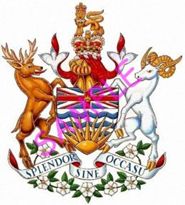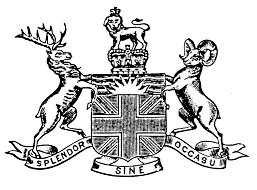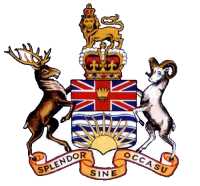British Columbia's Coat of Arms
British Columbia's Coat of Arms is one of the most important elements in our visual heritage. It’s a symbol of our sovereignty and our co-sovereign status as a province of Canada.

The Coat of Arms of British Columbia is one of the most important elements of the province’s visual heritage. Since its initial creation by Canon Arthur Beanlands and its being granted by Royal Warrant of Her Majesty Queen Elizabeth II in 1987, the Coat of Arms of British Columbia has been symbolic of the sovereignty, the supreme power and the authority of the Province to create and enforce laws so as to govern itself. It also serves to define B.C.’s co-sovereign status as a province of Canada.
The Coat of Arms of British Columbia is reserved for use by the three branches of government only: the Executive branch (Lieutenant Governor, Premier and Cabinet), the Legislative branch (Members of the Legislative Assembly elected by the citizens of British Columbia) and the Judicial branch (the Provincial and Supreme Courts of British Columbia and the British Columbia Court of Appeal). The Coat of Arms can be affixed to provincial possessions like court houses, public schools and government office buildings; and can be stamped, printed or engraved upon documents, certificates and proclamations issued by any of the three branches of government. The Coat of Arms does not represent the public service division of government.
Heraldry and coats of arms were developed in the 12th century to serve a purpose on the Medieval battlefield similar to the purpose present-day sporting uniforms play: they helped participants and spectators quickly recognize the allies and the opposition. Because very few people in Medieval times knew how to read and write, heraldic arms were adapted to embossed emblems or seals so that the owner of the emblem could authenticate documents written in their name.
Below is a description of the symbolism within the provincial Coat of Arms:1
Arms – The Royal Union Flag, with an antique crown in the centre, symbolizes the province’s origin as a British colony. The three wavy blue bars represent the Pacific Ocean. The sun signifies British Columbia’s location as the most westerly province in Canada.
Crest – The crowned lion – the Royal Crest of the United Kingdom – was used as the emblem of the province for many years. The lion is differenced by a garland of Pacific dogwoods, the provincial flower, around its neck.
Supporters – A wapiti stag and a bighorn sheep represent the colonies of Vancouver Island and British Columbia. Together they represent the colonies’ union in 1866. They stand on a compartment of the provincial flower, the Pacific dogwood.
Motto – Splendor sine occasu, this Latin phrase means “Splendour without diminishment”. The motto refers to the sun on the shield, which, although setting, never decreases.
The symbolism apparent in the province’s Coat of Arms is central to the other visual emblems that the province employs to reinforce its sovereignty: the provincial Shield, Great Seal and flag.
1 Canadian Heraldic Authority, “The Province of British Columbia, Registration of Arms and Flag.” GG.ca. http://reg.gg.ca/heraldry/pub-reg/project.asp?lang=e&ProjectID=1406&ShowAll=1 (accessed June 29, 2017).
Using B.C.'s Coat of Arms
The Coat of Arms of British Columbia is reserved for use by the three branches of government only: the Executive branch (Lieutenant Governor, Premier and Cabinet), the Legislative branch (Members of the Legislative Assembly elected by the citizens of British Columbia) and the Judicial branch (the Provincial and Supreme Courts of British Columbia and the British Columbia Court of Appeal).
Anyone else must first receive permission to assume, display or use B.C.’s Coat of Arms or any design closely resembling it. Contact the B.C. Protocol office to enquire about permission to use B.C.’s Coat of Arms.
History
The evolution of our Coat of Arms took over 90 years:
- 1895, B.C.'s Coat of Arms was created
- 1906, B.C. was granted arms
- 1987, B.C.'s Coat of Arms was completed
1895 - B.C.'s Coat of Arms Created

B.C.'s first Coat of Arms was adopted on July 19, 1895. It was created by Canon Arthur Beanlands of Victoria and included symbols that reflected the views and beliefs of B.C. at the time, such as:
- The Union Jack, placed in the lower part of the shield to represent unity with the British nation
- The wavy blue bars, representing the sea
- The setting sun, representing the stability and glory of B.C. and reinforcing the motto Splendor Sine Occasu which translates to "Splendour Without Diminishment"
- The two supporters of the shield, the wapiti stag of Vancouver Island and the big horn sheep of the Mainland, representing the union of the two colonies in 1866
- The Royal Crest that, in Beanlands’ opinion, represented B.C.'s expression of loyalty to the Crown
1906 - B.C. Received Arms

In 1897, B.C. attempted to register the arms at the College of Arms. Problems with Beanlands' design became apparent, such as:
- The Union Jack was in an inferior position on the shield
- Infringement of the Sovereign’s exclusive right to the Union Jack symbol, violating an essential element of heraldic practice stating that no arms or parts of an armorial achievement could be used by another
It took several years to resolve the issues, but on March 31, 1906, B.C. was granted arms by Royal Warrant of Edward VII. However, only the shield and motto were granted arms and they included the following changes:
- The sun and Union Jack were reversed to conform to proper heraldic practice
- A golden antique crown was added in the centre point of the Union Jack
B.C. continued to use the Royal Crest and supporters, but didn’t seek a grant to use them at the time.
1987 - Coat of Arms Completed

On October 15, 1987, the remaining elements of B.C.'s Coat of Arms were granted by Her Majesty Queen Elizabeth II.
- A collar of dogwood flowers was added to the Royal Crest
- The golden helmet of sovereignty was placed between the shield and crest to mark B.C.'s co-sovereign status in Canada
- Traditional heraldic elements of a wreath and mantling were added above the helmet.
- A chain of dogwood flowers was entwined around the motto scroll
